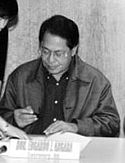Philippine Senate election, 2001
|
|
||||||||||||||||||||||||||||||||||||||||
|---|---|---|---|---|---|---|---|---|---|---|---|---|---|---|---|---|---|---|---|---|---|---|---|---|---|---|---|---|---|---|---|---|---|---|---|---|---|---|---|---|
|
||||||||||||||||||||||||||||||||||||||||
|
12 (of the 24) seats to the Senate of the Philippines and one mid-term vacancy 12 seats needed for a majority |
||||||||||||||||||||||||||||||||||||||||
|
||||||||||||||||||||||||||||||||||||||||
|
||||||||||||||||||||||||||||||||||||||||
Aquilino Pimentel, Jr.
PDP-Laban
The senatorial election was held in the Philippines on May 14, 2001 Independent candidate Noli de Castro, a former television anchor of TV Patrol of ABS-CBN was announced as the topnotcher. This is the first synchronized national and local elections held after the ouster of Former President Joseph Estrada in January due to a military-backed civilian uprising (popularly known as EDSA II).
The two competing coalitions in this election were the People Power Coalition (PPC) which supported Estrada's ouster, and the Puwersa ng Masa (Force of the Masses) coalition that supported Estrada. The PPC was composed of Lakas-NUCD-UMDP, Reporma-LM, Aksyon Demokratiko, PROMDI, Liberal Party and the PDP-Laban; the Puwersa ng Masa included the LDP, Partido ng Masang Pilipino and other pro-Estrada independents. There were supposed to be twelve seats to be contested but with the appointment of Teofisto Guingona as vice president, the Commission on Elections ruled that the thirteenth-placed candidate will serve the remainder of Guingona's term.
...
Wikipedia


